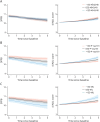Associations Between Blood-Based Biomarkers and Cognitive and Functional Trajectories Among Participants of the MEMENTO Cohort
- PMID: 38626384
- PMCID: PMC11175638
- DOI: 10.1212/WNL.0000000000209307
Associations Between Blood-Based Biomarkers and Cognitive and Functional Trajectories Among Participants of the MEMENTO Cohort
Erratum in
-
Associations Between Blood-Based Biomarkers and Cognitive and Functional Trajectories Among Participants of the MEMENTO Cohort.Neurology. 2025 Apr 8;104(7):e213521. doi: 10.1212/WNL.0000000000213521. Epub 2025 Mar 19. Neurology. 2025. PMID: 40106747 Free PMC article. No abstract available.
Abstract
Background and objectives: Elevated levels of Alzheimer disease (AD) blood-based biomarkers are associated with accelerated cognitive decline. However, their distinct relationships with specific cognitive and functional domains require further investigation. We aimed at estimating the associations between AD blood-based biomarkers and the trajectories of distinct cognitive and functional domains over a 5-year follow-up period.
Methods: We conducted a clinic-based prospective study using data from the MEMENTO study, a nationwide French cohort. We selected dementia-free individuals at baseline aged 60 years or older. Baseline measurements of β-amyloid (Aβ) 40 and 42, phosphorylated tau (p-tau181), and neurofilament light chain (NfL) concentrations were obtained using the Simoa HD-X analyzer. Mini-Mental State Examination (MMSE), Free and Cued Selective Reminding Test (FCSRT), animal fluency, Trail Making Tests A and B, Short Physical Performance Battery (SPPB), and Instrumental Activities of Daily Living were administered annually for up to 5 years. We used linear mixed models, adjusted for potential confounders, to model AD biomarkers' relation with cognitive and functional decline.
Results: A total of 1,938 participants were included in this study, with a mean (SD) baseline age of 72.8 (6.6) years, and 62% were women. Higher baseline p-tau181 and NfL were associated with significantly faster decline in most cognitive, physical, and functional outcomes (+1 SD p-tau181: βMMSE = -0.055, 95% CI -0.067 to -0.043, βFCSRT = -0.034, 95% CI -0.043 to -0.025, βfluency = -0.029, 95% CI -0.038 to -0.020, βSPPB = -0.040, 95% CI -0.057 to -0.022, and β4IADL = -0.115, 95% CI 0.091-0.140. +1 SD NfL: βMMSE = -0.039, 95% CI -0.053 to -0.025, βFCSRT = -0.022, 95% CI -0.032 to -0.012, βfluency = -0.014, 95% CI -0.024 to -0.004, and β4IADL = 0.077, 95% CI 0.048-0.105). A multiplicative association of p-tau181 and NfL with worsening cognitive and functional trajectories was evidenced. Lower Aβ42/40 ratio was only associated with slightly faster cognitive decline in FCSRT and semantic fluency (+1 SD: β = 0.011, 95% CI 0.002-0.020, and β = 0.011, 95% CI 0.003-0.020, respectively). These associations were not modified by APOE ε4, sex, nor education level.
Discussion: In a memory clinic sample, p-tau181 and NfL, both independently and jointly, are linked to more pronounced cognitive, physical and functional declines. Blood-based biomarker measurement in AD research may provide useful insights regarding biological processes underlying cognitive, physical, and functional declines in at-risk individuals.
Conflict of interest statement
The authors report no relevant disclosures. Go to
Figures



References
MeSH terms
Substances
LinkOut - more resources
Full Text Sources
Medical
Miscellaneous
